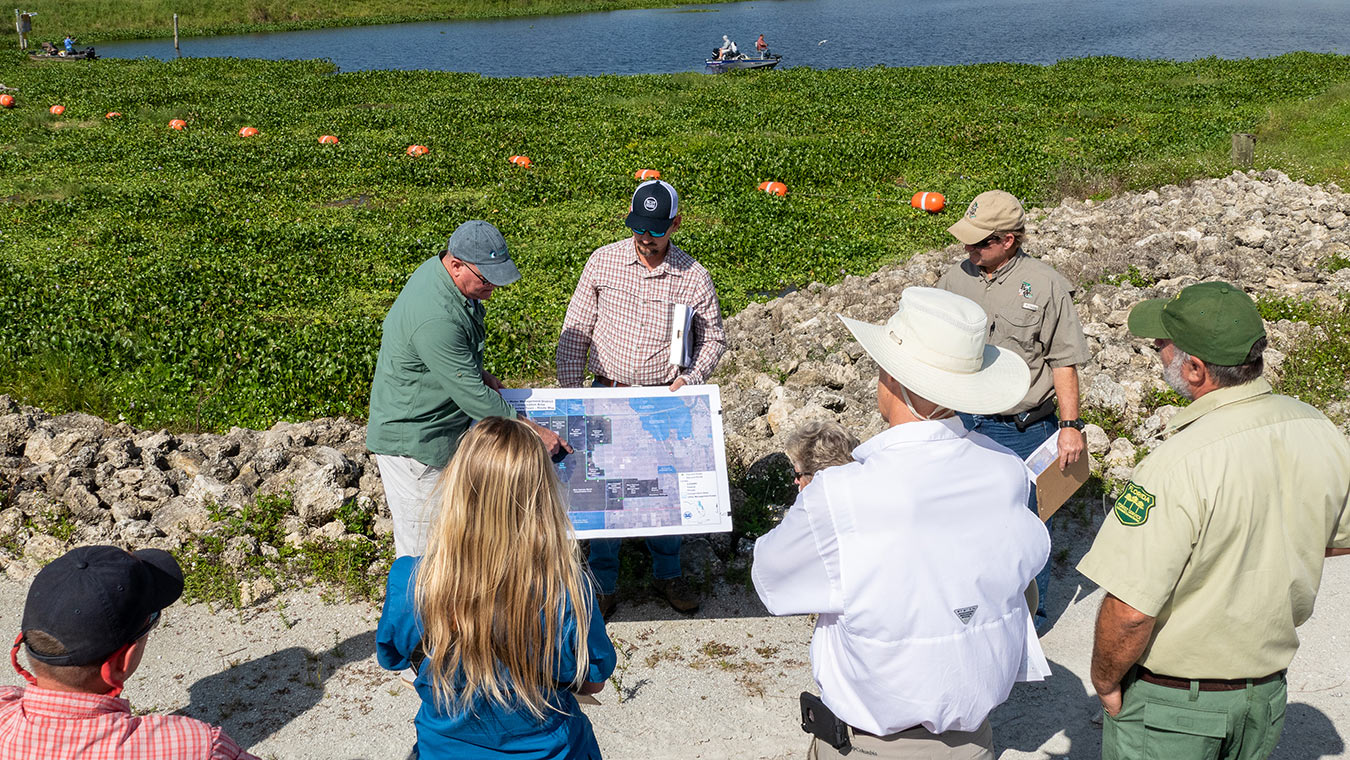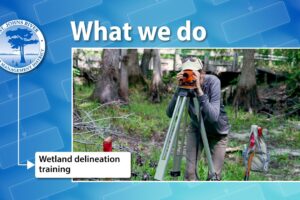It takes a village
Partnerships ensure District lands are managed to meet multiple missions
It’s judgment day at the Blue Cypress Conservation Area in Indian River County.
In a parking lot at the headwaters of the St. Johns River — a mosaic of open water, sawgrass marsh and restored wetlands — about a dozen people await a tour of the 61,574-acre public property. A red-shouldered hawk glides overhead; an airboat roars in the distance.
This isn’t just any tour group. Invitees include officials with the Florida Department of Environmental Protection (DEP), Indian River County Soil and Water Conservation District, Audubon Florida and ranchers whose land abuts Blue Cypress. They’re here to evaluate whether the St. Johns River Water Management District is managing this vast, complex and, oftentimes, breathtaking property according to plans.
District Land Resource Specialist Brent Bachelder welcomes the participants, who serve as the Land Management Review Team for this particular property. Their participation ensures the review process is comprehensive and transparent.
“They’ll evaluate the extent to which we are protecting such things as native and protected species, archaeological resources, water resources and public access,” Bachelder explains. “Every participating stakeholder brings a broad breadth of knowledge to the review. We use their input to help us improve our management plan for each of the District’s properties.”
Land Management Review Teams (LMRT) are required by Florida Statutes as a form of “checks and balances” to ensure the District’s land managers are following the agency’s governing board-approved management plans. The District hosts a minimum of five LMRT meetings a year throughout its 18-county service area. In 2019, nine separate review teams were composed of 43 individual stakeholders and 23 separate organizations. It’s an ambitious endeavor, given that the District manages approximately 425,000 of the 772,987 acres of land it assisted in purchasing, has a conservation easement over or through similar partial ownership interest.
Bachelder lays out the route for the four-hour tour. The team will visit preselected locations and evaluate whether tasks listed in the Blue Cypress land management plan have been completed at each site or whether more work is needed. There’s a lot to take in: At more than 61,000 acres, Blue Cypress is one of the District’s largest public properties. Team members are provided with a tour route map, natural communities map, fire management map and a variety of other informational materials to aid them in their review.
Following the tour, the LMRT will evaluate how well the District has addressed all its management objectives by completing a detailed checklist. Each LMRT meeting concludes with the team members reaching consensus as to whether the property is being managed in compliance with its approved land management plan.
A property’s characteristics can change over time.
District land management plans are updated on a 10-year life cycle. LMRT results are incorporated into the revision process. The Blue Cypress Land Management Plan was last updated in 2008, so it was time for a review.
“A property’s characteristics can change over time. Restoration projects or other factors require us to reexamine how we manage a property,” Bachelder says. “We use the information we gather from the review teams’ experts to adopt new management procedures and include them in the updated management plan.”
The first stop: a sawgrass marsh in Blue Cypress. This marsh shows all the signs of a healthy wetland. District staff use it as a reference site, acting as a yardstick against which to measure other expanses of sawgrass marsh. LMRT members are duly impressed.
A convoy of District trucks and SUVs drives slowly along the area’s levees as Bachelder narrates. During the tour, a cadre of District staff use walkie talkies so all LMRT members can listen or ask questions. As the tour progresses, Bachelder points out upgraded water control structures, thousands of acres of marsh managed with hydrology and prescribed fire and areas that have been chemically treated to knock back invasive plant species, such as Carolina willow and Old World climbing fern. The climbing fern invades ecologically sensitive areas reducing plant diversity and degrading habitats. It also acts as a fire ladder, causing great destruction by carrying fire into the canopy and other areas not adapted to fire.
“Over there, we treated 16,000 acres of Old World climbing fern,” Bachelder tells the group. “We also completed 5,000 acres of willow treatment, promoting restoration of the former herbaceous marsh.”
Catie Welch, one of the LMRT members, is a DEP environmental specialist for Kissimmee Prairie Preserve State Park. She’s grateful for the opportunity to review the District’s work up close.
“My land manager sends me to these LMRT tours so that I get a sense of how other agencies manage their properties,” she says. “Being a good steward is not just a DEP problem. All agencies share similar challenges. The tour allows me to see the groundwork that has been successful for the District and learn how we can apply it to our properties.”
As the tour continues, Bachelder describes the direction and movement of water through canals, marshes and water management area impoundments, where nutrients are captured and stored. He points out water monitoring stations that use cellular telemetry to send hydrologic data to the District’s Palatka headquarters, helping District engineers make water control structure operation decisions.
Wendy Swindell, a conservation lands project specialist with Indian River County, is inspired by the LMRT process and the bonds that are forged between multiple agencies and stakeholder groups.
“We learn a lot of large-scale techniques and operations of the District that we can take back to Indian River County,” Swindell says. “St. Johns is dealing with many of the same issues that we are, such as prescribed fire and invasive plant management, but they’re doing it on a much larger scale. But the principles are the same.”
Chris Farrell, northeast Florida policy associate for Audubon Florida, believes LMRTs provide the perfect venue for the District to share decades of land management knowledge and experience while encouraging an open critique from LMRT participants.
We learn a lot of large-scale techniques and operations of the District that we can take back to Indian River County.
“District staff continue to impress me with their dedication to improving the ecological function of the public lands they manage,” Farrell says. “Additional ecological lift and improved public access could be achieved with additional staff and resources, but the District excels with the resources it has.”
The convoy makes a few more stops and then heads back to the parking lot. Each team member reviews their checklist, documenting their assessment of Blue Cypress’ management. Bachelder reads through the checklist aloud while team members follow along and rate each item on the list. Is the District monitoring water quality at Blue Cypress adequately? Check. Is the agency continuing to manage water levels to ensure the protection of the endangered snail kite? Check.
Someone asks about the District’s methods for tracking its prescribed fires.
“We have an annual burn plan so that our accomplishments are quantifiable,” responds Amy Copeland, Blue Cypress’s lead land manager. “We follow a comprehensive fire management plan and have a database that tracks our annual fire progress.” Copeland is a natural resource manager responsible for stewardship over District lands.
At the conclusion of the LMRT meeting, team members agree that management practices at Blue Cypress comply with the current land management plan. Upon returning to the office after a long day, Bachelder skims through the completed review checklists. Team members have provided abundant praise of the District’s management at Blue Cypress. The District has also gathered a few recommendations—in this case a request for additional staff and a survey of local wading birds—that will be incorporated into the forthcoming Blue Cypress Conservation Area land management plan revision. Importantly, the results of the LMRT will also be shared with the District’s Governing Board.
Bachelder concludes, “Being judged isn’t always pleasant. However, it’s always rewarding to show our stakeholders how much effort District staff applies toward managing the very special natural resources in our care. It is especially rewarding when those stakeholders are appreciative of the results the District has achieved.”






